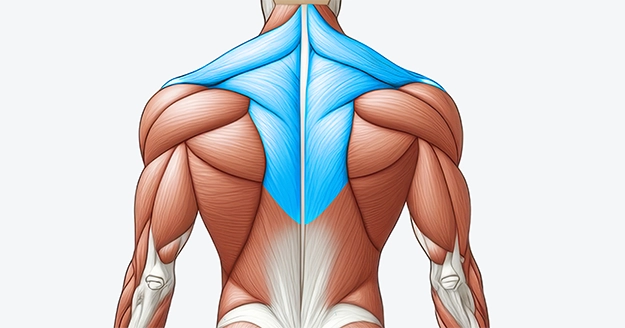Exercise Profile
Dumbbell Shrug Overview
The dumbbell shrug is a fundamental exercise that targets the upper trapezius muscles by raising your shoulders. It’s not just for building bigger traps—dumbbell shrug benefits shoulder girdle strength, posture, and shoulder joint stability.
The dumbbell shrug is a straightforward exercise suitable for all fitness levels, from beginners to advanced lifters. You can easily modify the set-up, weight, and repetitions to meet your goals, making it a great addition to your workout for building a thick and strong upper back.
By using them in your routine, you can support other lifts and improve upper body stability. They’re easy to add to any workout, whether as part of a shoulder or upper body day. By adding dumbbell shrugs, you’ll also help reduce the risk of shoulder injuries and improve overall muscular balance.

Dumbbell Shrug Instructions
Step 1: Stand erect with your feet hip-width apart, and hold a dumbbell in each hand. With your palms facing your body, extend your arms down your sides.
Step 2: Make sure you have your chest out and up and your back is straight.
Step 3: Elevate your shoulders as high as possible while your arms remain extended. Bring your shoulders toward your ears, then briefly pause at the top.
Step 4: Under control, lower the dumbbells back to the starting position.

Common Dumbbell Shrug Variations
If you’re looking to add variety to your shoulder and trap workouts, there are several effective dumbbell shrug variations to try. Each targets your muscles in slightly different ways, helping you break through plateaus and build more balanced strength and muscle mass. Here are some common dumbbell shrug variations to incorporate into your routine:
Dumbbell Shrug Tips
- To enhance trap activation, use a neutral hold with your palms toward your body.
- Throughout the exercise, keep your core active to maintain stability.
- Avoid lifting overly heavy weights that could compromise your form.
Dumbbell Shrug Common Mistakes
- Rounding Shoulders: Allowing your shoulders to round forward instead of keeping them back can reduce the effectiveness of the exercise and strain your neck.
- Bending Your Arms: Relying on your arms to lift the weights instead of focusing on using your traps will diminish the exercise’s effectiveness.
- Excessive Weight Use: Using too heavy weights could lead to bad form and increase the risk of getting hurt. It’s important to choose a manageable weight to maintain control.
Frequently Asked Questions
What is the best grip for dumbbell shrugs?
A neutral grip (palms facing your body) is commonly recommended as it can help reduce shoulder strain and allows for better trap engagement.
How can I tell if the weight I’m using is appropriate?
If you use the right weight, you should be able to do the exercise properly while still finding the final few repetitions of each set difficult. If you can easily complete all reps without effort, consider increasing the weight.
What’s the difference between dumbbell shrugs and barbell shrugs?
Both target similar muscle groups, but because each side works independently, dumbbell shrugs provide a wider range of motion and can help correct muscular imbalances.
Post your post-workout selfies in IG and tag @trainestapp, #trainest, or DM them to us to get a shoutout on Trainest Stories!


